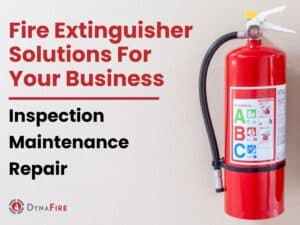You’ve got questions; we’ve got answers – about the lifesaving red cylinders hanging on your walls. Our Winter Park fire extinguisher maintenance team is spreading their knowledge about fire extinguishers.
The fire extinguisher likely close to you right now can be your first line of defense against a fire. These portable devices can put out small fires or allow safe egress in case of an evacuation. At DynaFire, we want to ensure that you have the fire extinguishers you need and that they work correctly. We also want you and your building occupants to know how they work and how they should be maintained.
We’ve gathered our clients’ frequently asked questions so you’ll be better informed about fire extinguisher usage and better prepared in an emergency.
Why Do Fire Extinguishers Have Tags?
Perhaps you didn’t notice as you rushed to your next meeting, but that fire extinguisher you just passed has a tag attached. And just like the tag on your mattress that should not be removed (under penalty of law!), your fire extinguisher’s tag must always stay put. By the way, it turns out that once you purchase your mattress, you can remove the tag – if you were wondering.
The purpose of a fire extinguisher tag is to keep a record of its last inspection, and must include the following information:
- Month and year of previous inspection
- The person who performed the inspection
- The agency responsible for the inspection
While we’re on the topic of recordkeeping, each fire extinguisher must also have a verification-of-service collar around its neck if it has had an internal examination. This collar must list the month and year the service was performed and the agency that performed the work.
Inspections are crucial to the performance of a fire extinguisher, and these little tags are a great way to keep fire extinguisher maintenance top-of-mind.
Are All Fire Extinguishers The Same?
No; fire extinguishers are available in several different types to extinguish different types of fires. Fires are classified by the kind of materials burning, which indicates what type of extinguishant is needed to put it out. Generally, these are your fire extinguisher choices:
- Type A uses pressurized water on Class A fires like wood and paper.
- Type ABC uses dry chemicals for Class A fires, Class B fires (flammable liquids like oil and gas), and Class C fires (electrical).
- Type BC uses carbon dioxide for chemical or electrical fires.
- Type K is used in kitchens for grease fires.
If you’re unsure what type of fire extinguisher your facility needs, our Winter Park fire extinguisher maintenance team can assist you.
How Do You Use A Fire Extinguisher?
Having fire extinguishers properly installed around your facility is a smart way to be prepared. As part of a complete Fire & Life Safety plan, your building occupants must know how to use them if needed. You don’t want them to have to figure it out on the fly!
When operating a fire extinguisher, just remember the PASS method:
P – Pull the pin.
A – Aim at the base of the fire.
S – Squeeze the handle.
S – Sweep the fire extinguisher from side to side.
We recommend posting instructions next to your fire extinguishers and encouraging your building occupants to familiarize themselves with proper fire extinguisher usage.
Do Fire Extinguishers Expire?
Although fire extinguishers don’t have a strict expiration date, they do not last forever. Rechargeable fire extinguishers can last longer than non-rechargeable ones if you keep them on a regular maintenance schedule.
Non-rechargeable fire extinguishers have a life expectancy of 10-12 years and should typically be replaced every ten years. Our Winter Park fire extinguisher maintenance personnel can advise you on an appropriate replacement schedule.
How Often Should Fire Extinguishers Be Tested?
To get the longest life from your fire extinguisher, it must be inspected, serviced, and tested regularly. Only certified professionals can perform these maintenance tasks, so you must partner with a Fire & Life Safety company like ours to keep your fire extinguishers in tip-top shape.
We follow NFPA testing guidelines:
Annual fire extinguisher maintenance involves a thorough examination followed by repairs or a replacement if necessary.
Six-year maintenance includes emptying, inspecting, and refilling the fire extinguisher.
Five and 12-year maintenance involves hydrostatic pressure testing.
It’s essential to keep your fire extinguishers on a regular testing schedule, and we can help you with that.
Why Trust DynaFire With Your Winter Park Fire Extinguisher Maintenance?
DynaFire has kept Central Florida businesses safe for 20 years by providing best-in-class products and exceptional customer service. Have more fire extinguisher questions? We’d love to answer them for you! Contact us today for more information.






